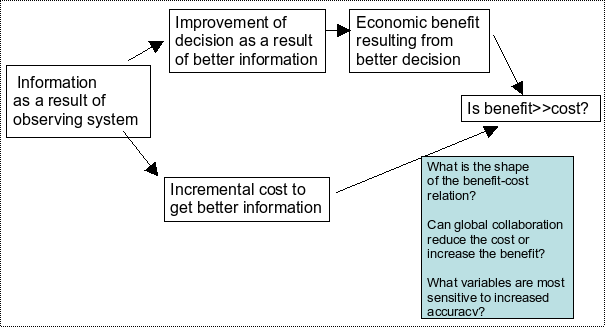Development of a conceptual model for GEOBENE
At the project meeting in 2007 it was acknowledged that GEOBENE should adopt a shared conceptual model. Based on this the CSIR team proposed the following four recommendations:
- The conceptual model should be based on marginal cost-benefit analysis with case studies qualitatively or quantitatively following the benefit chain pathway proposed (Figure 1).
- The ‘topology’ of the benefit-effort and the cost-effort curves in the vicinity of the current state are often as useful for policy purposes as actual valuations
- All SBA’s and case studies need to ask the question ‘how will globalization of this information lead to greater net benefits?’
- All studies should undertake some form of sensitivity analysis to help understand in which variables (or which parts of the world) better observations lead to the greatest improvements of welfare [or in accuracy of information for decision-making, as a proxy]

Figure 1: The benefit chain concept. The key elements are that both benefits and costs need to be considered; it deals in incremental changes rather than total benefits and costs; that a logical causal pathway needs to established, in several steps if necessary; and that much of the analysis is semi-quantitative (‘is the benefit an order of magnitude greater than the cost’) or qualitative (‘what is the shape of the cost-benefit curve’)
This model was presented at the meeting and subsequently prepared for publication with the IIASA team in the Journal of IEEE (Fritz et al. In Review).
